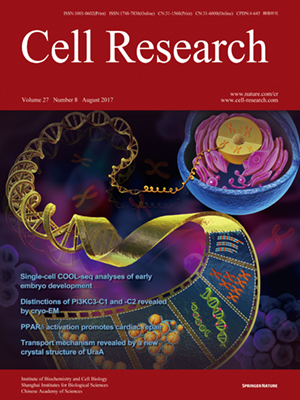
Volume 27, No 8, Aug 2017
ISSN: 1001-0602
EISSN: 1748-7838 2018
impact factor 17.848*
(Clarivate Analytics, 2019)
Volume 27 Issue 8, August 2017: 989-1001
ORIGINAL ARTICLES
Cryo-EM structure and biochemical analysis reveal the basis of the functional difference between human PI3KC3-C1 and -C2
Meisheng Ma1,*, Jun-Jie Liu2,3,6,*, Yan Li2, Yuwei Huang1,3, Na Ta1, Yang Chen1, Hua Fu4, Ming-Da Ye2, Yuehe Ding5, Weijiao Huang2, Jia Wang2, Meng-Qiu Dong5, Li Yu1 and Hong-Wei Wang2
1The State Key Laboratory of Membrane Biology, Tsinghua University-Peking University Joint Center for Life Sciences, School of Life Sciences, Tsinghua University, Beijing 100084, China
2Ministry of Education Key Laboratory of Protein Sciences, Tsinghua-Peking Joint Center for Life Sciences, Beijing Advanced Innovation Center for Structural Biology, School of Life Sciences, Tsinghua University, Beijing 100084, China
3Joint Graduate Program of Peking-Tsinghua-National Institute of Biological Science, Tsinghua University, Beijing 100084, China
4MOH Key Laboratory of Systems Biology of Pathogens, Institute of Pathogen Biology, Chinese Academy of Medical Sciences & Peking Union Medical College, Beijing 100730, China
5National Institute of Biological Sciences, Beijing 102206, China
6Current address: Molecular Biophysics and Integrated Bioimaging Division, Lawrence Berkeley National Laboratory, Berkeley, CA 94720, USA
Correspondence: Li Yu, E-mail: liyulab@mail.tsinghua.edu.cn; Hong-Wei Wang,(hongweiwang@tsinghua.edu.cn)
Phosphatidylinositol 3-phosphate (PI3P) plays essential roles in vesicular trafficking, organelle biogenesis and autophagy. Two class III phosphatidylinositol 3-kinase (PI3KC3) complexes have been identified in mammals, the ATG14L complex (PI3KC3-C1) and the UVRAG complex (PI3KC3-C2). PI3KC3-C1 is crucial for autophagosome biogenesis, and PI3KC3-C2 is involved in various membrane trafficking events. Here we report the cryo-EM structures of human PI3KC3-C1 and PI3KC3-C2 at sub-nanometer resolution. The two structures share a common L-shaped overall architecture with distinct features. EM examination revealed that PI3KC3-C1 “stands up” on lipid monolayers, with the ATG14L BATs domain and the VPS34 C-terminal domain (CTD) directly contacting the membrane. Biochemical dissection indicated that the ATG14L BATs domain is responsible for membrane anchoring, whereas the CTD of VPS34 determines the orientation. Furthermore, PI3KC3-C2 binds much more weakly than PI3KC3-C1 to both PI-containing liposomes and purified endoplasmic reticulum (ER) vesicles, a property that is specifically determined by the ATG14L BATs domain. The in vivo ER localization analysis indicated that the BATs domain was required for ER localization of PI3KC3. We propose that the different lipid binding capacity is the key factor that differentiates the functions of PI3KC3-C1 and PI3KC3-C2 in autophagy.
10.1038/cr.2017.94
FULL TEXT | PDF
Browse 2362


